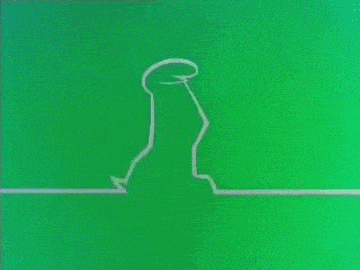How La Linea Made Waves with One Line Animation
© Osvaldo Cavandoli
Digital art, CGI, and 4D cartoons are no strangers to us. Not quite childish and not really grown-up, these forms of entertainment stir the same excitement in us, as it does in our kids.
We quietly look forward to watching the next animated cartoon by Disney Pixar on the big screen. Mainly for the impressive technology, a moving storyline, and an engrossing 1.5-hour.
But Toy Story, Coco, and Finding Nemo, are not the only animated movies that have captured hearts worldwide. One of their predecessors did the same through more humble means.
Using one line art. Or more specifically, one line animation.
The timeless animation is La Linea, also known as The Line in English. Although many of our generation may not know it, La Linea has a cult classic status worldwide.
The question is, how could single line drawing produce such a significant entertainment piece? And how much did it influence popular culture? Keep reading as we answer these and other questions.
A Defining Line Animation Series
La Linea is an Italian animated series created by cartoonist Osvaldo Cavandoli. It was originally broadcast in Italy between 1971 and 1986 with each episode running from 2 to 6 minutes.
The series is about a spirited little character with a striking nose known as Mr. Linea, formed from single line drawing. Apart from the nose, the character does not have any other distinctive features such as eyes, ears, or lips.
Mr. Linea comes into life as a simple white line drawn by the hand of the animator and the story progresses with every stroke.
Does Mr. Linea speak? Yes, but it’s mostly gibberish with a smattering of Italian or English words. Despite that, La Linea is universally understood.
La Linea’s Allure
So, what makes this series so appealing? At one glance, it does not seem as if La Linea has much going for it.
It needs to convey meaning and story in less than 10 minutes, without coherent dialog and using only 2 basic visual elements:
A single line with the same stroke and a single-color background.
It’s a far cry from the films we’re accustomed to in this genre. And still enough to produce complete animated stories spanning 90 episodes and convey emotions to anyone in the world.
Although the beginnings and the endings are similar throughout the series, every episode has its own storyline.
The narrative unfolds when Mr. Linea explores his world, which is made of the same continuous line that forms him. He depends on his animator entirely to draw out his journey and the story.
With simple strokes, the animator transforms the single line into a number of objects. A loop becomes a ball for instance, or an angle becomes the step of a staircase.
But the stories these objects lead to are anything but dull.
Mr. Linea often finds himself in trouble when playfully interacting with the environment and objects the animator creates.
One line art is used so skillfully to create challenges and funny scenes in La Linea that everyone can relate to them.
Viewers can’t help but draw a parallel between each incident that the character encounters and their own real-life experiences.
When the line continues without interruption, Mr. Linea just walks. But when there are gaps or waves, the fun begins. And the rhythm of the animation picks up.
Clues to an approaching climax are also signaled through the changing color of the background. A transition from green to red indicates that something funny is about to happen. When the background turns from red to blue, the character is more composed.
Mr. Linea’s emotions such as frustration, fear, anger, relief, pride, and joy are all conveyed using minimalist line art. And cleverly strengthened further with the change in background color and pace.
It’s easy to see why it didn’t take long for this line animation to achieve international stardom.
Swimming Upwards Towards Mainstream
The series ended up airing in more than 50 countries around the world including the US, UK, Canada, South Africa, Australia, Israel, Sweden, Poland, Hungary, and Argentina.
It also birthed a comic strip, books, more short movies, promotional merchandise, and countless homages and parodies. Mr. Linea also made appearances in many other media.
In 2005, Jamiroquai paid homage to La Linea in the video clip (Don't) Give Hate a Chance. It featured 3D representations of the line character, as well as the animator's hand and pencil.
Ford ran a TV ad campaign for its C-MAX hybrid using La Linea in October 2012.
The inspiration for La Linea as an animation series was largely conceived by minimalist line art. No other element plays a bigger role than the single line in determining the fate of Mr. Linea, and the journey he will embark on in any given episode.
Under these circumstances, most would have expected the series to make little more than a whisper in the entertainment industry. Instead, La Linea went on to enjoy roaring success. Proving that line art animation in its most basic form, without all the complexities of modern digital technology, still has the capacity to convey meaning, emotions, and drama.




